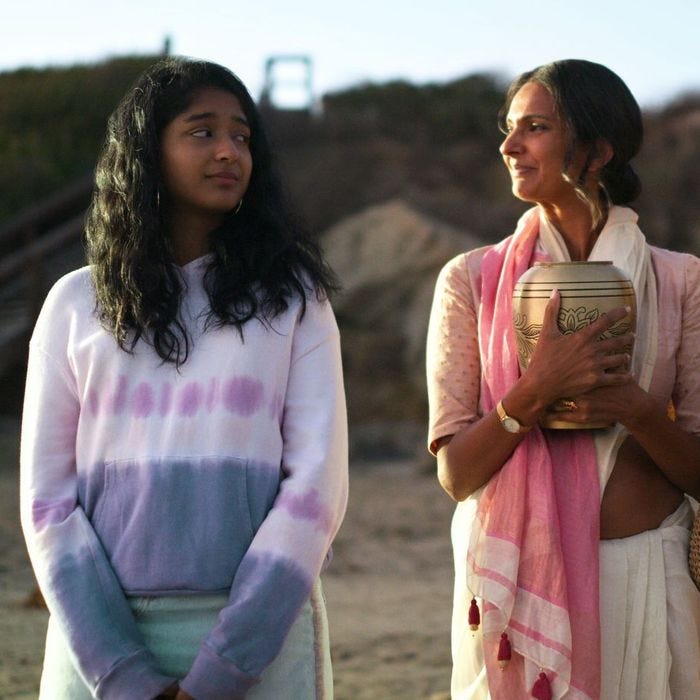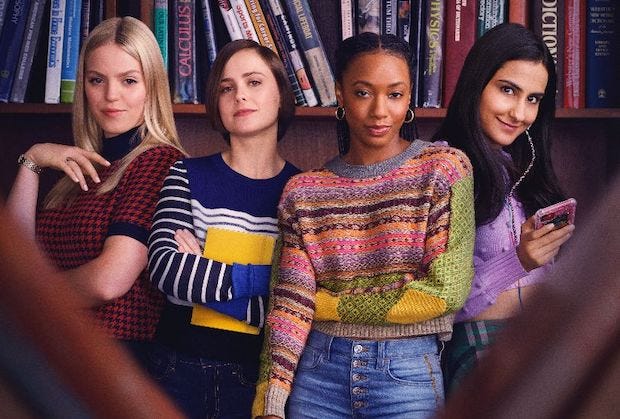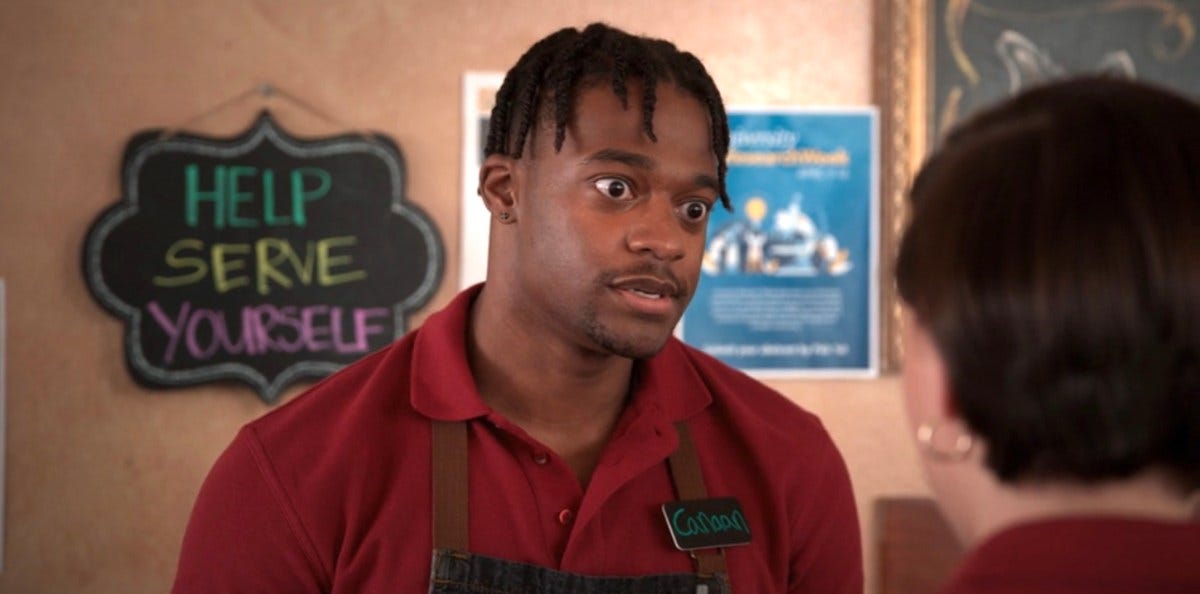The Strengths and Shortfalls of Mindy Kaling’s "The Sex Lives of College Girls" and "Never Have I Ever"
Kaling's latest streaming successes are both entertaining, and make some strides for representation. But they fall short when it comes to deeper analyses of class and race dynamics.
Warning: Spoilers ahead for season 1 of “The Sex Lives of College Girls” and light spoilers for seasons 1 and 2 of “Never Have I Ever”
Oof. These past few weeks have gotten dark. For some lighter fare, check out HBO Max’s “The Sex Lives of College Girls,” which for fun factor alone I would recommend. The first season finale aired earlier this month.
I was pretty excited to start the show. While there are countless series that take place in high school, comparatively few take place in college, that special period of life where you can do basically whatever you want but you don’t have to pay for your own snacks yet. The show is co-produced by Mindy Kaling, on the heels of the success of Netflix’s “Never Have I Ever,” the popular teen show she created. Clearly, she is on a streaming production roll.
Despite how much I liked “Never Have I Ever,” I haven’t been a fan of everything Kaling has done. Her show, “The Mindy Project,” (2012-2018) had some good moments, but was overall uneven. Though Kaling herself was always charming, and in some episodes showed a lot of emotional range, I found many of the supporting characters tiresome. I gave up around the third season.
Since her breakout as a writer and actress in “The Office,” Kaling has become inarguably the most famous Indian-American woman in comedy, and her success is an important example of representation in Hollywood. She is outspoken about having a normal body, and about double-standards for women in the industry, and she frequently calls out sexism in her projects. Still, when it comes to portrayals of class and race, Kaling sometimes misses. While her work certainly provides a breath of fresh air from the white male actors who dominate the comedy world, it sometimes veers into stereotypes, and doesn’t usually go into any deeper examinations of racism and class conflict.
“Never Have I Ever” does give its characters some depth beyond the tropes. The protagonist Devi’s mom, Nalini, is a typical strict Indian parent, but she isn’t one-note. We’re privy to her inner conflict about how to deal with her rebellious teenage daughter, who always got along better with her recently-deceased father. As Poorna Jagannathan, who plays Nalini, told the Los Angeles Times:
As minorities, our screen time is increasing… We are featured more and fill more and more roles. [It's] a huge win. But our 'seen time' remains low. ... Character arcs for minorities still feel underdeveloped and stereotypical. As a result, the audience doesn't fully see us. They don't get the three-dimensional version of us, and it's that version that moves the needle. That's the version that can create empathy, understanding and change.
Representation, that is, needs to go beyond tokenism and give depth, warmth, and humanity to its characters. I’d argue “Never Have I Ever” mostly succeeds in this endeavor.
Devi’s cousin, Kamala, is one of my favorite characters. She is a brilliant and (much to Devi’s annoyance) beautiful doctoral student at CalTech. She is facing pressure to have an arranged marriage, but the show pushes back somewhat on the idea that this is an oppressive practice she needs saving from. The second season focuses somewhat more on her challenges with a mentor in her program, who refuses to put her name as an author on a paper she worked on.
In its first season, the show faced criticism for its lack of positive representation of Muslim Indian-Americans, and its uncritical portrayal of Islamophobia among Hindu Indians. In the second season, it introduces a new Muslim Indian-American character, Aneesa, in the second season, who serves as a frenemy to Devi. While positive and nuanced representation is one thing, however, the show misses an opportunity to explain itself in exploring anti-Muslim sentiment amid a period of rampant nationalism in India.
Some critics went further in calling out the show for only portraying upper-class, highly-educated Indian-American characters, rather than a broader class cross-section. “Kaling is more interested in packaging Indian upper-caste Hindu American identity for the white gaze than she is in authentic storytelling,” wrote one such review by Monica M in Wear Your Voice magazine. “Shows like these continually erase the complex dynamics of South Asian experience and place their heads in the sand when it comes to critical socio-political realities that ground their shows.” Obviously, it’s a lighthearted show overall about relationships, not geopolitics, but I don’t think it would have been that hard to insert even part of a scene to fleshing this out a bit more.
Where the show does excel is in its portrayal of Devi herself, who is probably one of the most realistic teen characters on television. She is boy-crazy, impulsive, selfish, and occasionally exasperating–though ultimately lovable. She is a person whose prefrontal cortex is clearly not fully developed yet. She acts like an actual teenager would, which is also refreshing, and funny (though often very cringeworthy).
The protagonists in “The Sex Lives of College Girls” are also teenagers, and exercise similar lapses in judgment, though with perhaps slightly more maturity that Devi might. It’s an ensemble comedy with four women leads, who play first-years suitemates at the fictional Essex College, a quintessential elite East coast school full of mostly privileged students. Kimberly (played by Timotheé’s sister, Pauline Chalamet) is a wide-eyed girl from Arizona, who unlike many of her peers, is on scholarship, meaning she has a student job. (I’ll note that at my privileged liberal arts college it was extremely common for students to be on work-study.)
Whitney (Alyah Chanelle Scott) is a Black soccer star who is having an affair with her soccer coach–and happens to be the daughter of a U.S. senator. Bela (Amrit Kaur) is an Indian-American aspiring comedy writer (sound familiar?) on the prowl, whose catchphrase is “sex-positive.” Then there’s Leighton, a blonde mean girl played by Reneé Rapp from the “Mean Girls” musical with a secret.
I was disappointed in the first few episodes of the show. I didn’t feel an immediate attachment to any of the characters, who felt a little performative and one-note. There were a number of moments that felt right out of 2010, though the show is supposed to take place now (which we know in part thanks to a very awkward and unwanted reference to Covid. Can we just not?)
In the pilot, sheltered Kimberly's conversation with her new Latina and Black coworkers, Lila (Isorelýs Paulino) and Canaan (Christopher Meyer) at the campus coffee shop is played for laughs, and seems to poke fun at how gullible white people are when buying into racial stereotypes. It doesn’t quite land. In this day and age, the cringeworthy scene makes the painfully awkward Kimberly come off as clueless and even racist.
Trying to make friends with Canaan, she opens the conversation with the alarmingly microaggressive question “Do you like Jay-Z?” It gets worse. “Look, I just want to say, I come from a small town in Arizona, and it’s really exciting for me to have a Black friend…. Or is it African American?” (This is a bit strange in and of itself because her suitemate, Whitney, is Black.) When she asks Canaan what it’s like to be Black at Essex, he decides to have a little fun.
“Oh… it’s hard. Not a lot of people here get me…. I don’t really tell a lot of people this, but my mom is addicted to crack.”
Kimberly totally buys it, and lays on a large dose of sympathy. Canaan, seeing how far he can take it, then tells Kimberly Lila’s personal story, one in which she is a single mom with a baby whose father is incarcerated. Lila, confused, realizes that Canaan told her this to mess with her, because “he knew you’d believe it because you’re a hick from shitsville, Arizoni.” (Also, Arizona is pretty diverse?)
Instead of learning a lesson about microaggressions, though, she says “Canaan, you’re such an asshole,” without an ounce of self-reflection. “So it was all bullshit? I bet your mom’s not even addicted to crack.”
“No, she’s a paralegal in Maryland,” he replies, deadpan. “Do you want my mom to be addicted to crack?”
Canaan’s delivery is great here, and it’s a funny comment, but there’s a wasted opportunity. When Canaan and Lila play the same trick on her again, Kimberly has the same reaction–she’s angry and aggrieved they are making fun of her instead of learning from her ignorance. Later in the episode, Kimberly stands up for Canaan and other “kind of poor” students by cursing out a rich kid who throws his candy bar wrapper in front of him to clean up. The scene is, I think, supposed to absolve her offensive views from before, but I still had a bad taste in my mouth. There’s also the fact that Canaan, who later becomes a love interest for Whitney, gets little character development himself.
Other plotlines start out predictably, including the first episode reveal that Leighton is so mean and standoffish because she’s a closeted lesbian. Again, this might have been shocking in 2010 but isn’t really now. In later episodes, I could see the enemies-to-lovers trope coming from miles away between Leighton and an out lesbian, Alicia, who works at a women’s center Leighton is forced to volunteer at for community service after she drunkenly defaces a statue, distraught because her high school best friends have ditched her (a pretty funny scene). When Leighton first arrives at the clinic, she is taken aback that she’s asked to state her pronouns and says, “she/her, obviously.” (My boyfriend walked past during this scene and said “oooooof.”) Leighton’s character is supposed to be from New York City, which, with her “Clueless” fashion style and conservative family, begs disbelief. Given the spate of progressive private schools in New York City, Leighton’s open disdain at having to introduce herself with gender pronouns feels incongruous. She’s a Gen Z-er from New York, not a midwestern baby boomer.
This plot reminded me of one in “The Bold Type,” a show that usually does a better job exploring young women’s sexuality, especially queer ones. In the fourth season, Kat, a leftist biracial bisexual woman, meets Ava, the conservative daughter of a board member at Scarlet, the magazine she’s just been fired from for being too pushy about her activism. Ava is a loud-and-proud lesbian, but she’s also conservative, and Kat struggles to understand how Ava can hold these two identities that seem so at odds. Eventually, the two hook up. Beyond creating plot, it’s hard to understand the point of this story arc, other than teaching Kat a Very Important Lesson about the importance of separating people from their politics in the middle of the Trump era.
A lot of fans hated this, and it turns out, so did the actors. In an open letter on Instagram, Aisha Dee, who played Kat, called attention to microaggressions and lack of diversity in the writers’ room and on set on “The Bold Type,” but especially surrounding the Kat/Ava plotline. “The decision to have Kat enter into a relationship with a privileged conservative woman felt confusing and out of character,” she wrote. “The Kat I know and love would never make these choices. It was heartbreaking to watch Kat’s story turn into a redemption story for someone else, someone who is complicit in the oppression of so many.”
Essentially the same thing happens between Leighton and Alicia. Though I rolled my eyes at first, the plotline didn’t rub me as negatively, I think because unlike Kat, Leighton is only 18, in the closet, and learning how to be a better person whose beliefs aren’t simply defined by her family. As one of the principal characters, the show gives more space for her to develop as a flawed and growing person. While I felt critical of Leighton in many parts of the show, her struggle with her identity felt especially raw and real as the show went on. I think her experience is especially germane to the college experience, when people are first exposed to new viewpoints and people from different backgrounds. Leighton has been miserable and self-hating, hiding her identity beyond a facade of mean brattiness, and college gives her that first opportunity to actually be herself… if she can only find the courage.
Bela, a character clearly based on Kaling herself, also takes a while to be fleshed out. Unlike Leighton, she knows who she is and exactly what she wants to be– she’s an aspiring comedy writer who desperately wants to write for the campus’s elite humor magazine, The Catullan. She’s also clearly overcompensating with her over-the-top declarations of sex positivity, perhaps a rebellion against her conservative Indian parents who (surprise) don’t want her pursuing a career in comedy. Things do get more interesting when she starts questioning the sexist, cliquey culture of The Catullan itself.
While it takes the show some episodes to find its footing, by midway through the season something shifted for me. The characters start becoming real friends and the audience becomes more invested in them, as twists that were predictable at first go in new and exciting directions. The parents’ weekend episode features a cringeworthy dinner but has some interesting revelations about the way that college, especially one full of rich kids, changes people. And one later episode centering around Kimberly’s sexual awakening is especially entertaining and hilarious and felt very true to the college experience (though obviously exaggerated).
Something else that I found refreshing about the series was the lack of drama between the women in it. For example, an early rivalry between Bela and Evangeline, another Asian female writer on The Catullan is quickly resolved and becomes a strong alliance. And when Leighton learns that Kimberly was secretly sleeping with Leighton’s brother, rather than having a big fight, she and Kimberly have a low-key, drama-free conversation about it, and make up immediately. Finally, after it comes out that Whitney–definitely the least developed character of the bunch–had an affair with her soccer coach, her teammates are supportive and don’t shame her for it. “It’s not your fault,” her teammate, also a former rival, says. I really appreciated that the show eschewed teen show tropes of jealousy and pettiness between its female characters in favor of camaraderie and respect.
The focus on female friendship exemplifies both the strengths and weaknesses of Mindy Kaling’s recent projects. Even when the broader race or class commentary doesn’t always work, she does a pretty good job with portrayals of sexism and female solidarity. And you always come to root for her characters, and grow to feel a connection with them, however flawed. This is also a testament to the strengths of some of the actors, especially Renée Rapp, who brings such pain and authenticity to her struggles with her sexual identity I found myself tearing up in the show’s last episode. For all the show’s shortcomings, I was pretty sad when I finished the season, and wanted more.
What I’m Watching: Friends, I gave in. I spent years refusing to watch “Succession,” despite everyone’s endless rhapsodizing about it, because I didn’t need another show about evil white rich people. What finally did me in was the New Yorker profile of actor Jeremy Strong, who plays oldest son Kendall Roy on the show. For a couple days late last month, Twitter couldn’t stop talking about this article (before omicron, there was the Jeremy Strong profile). So, apparently Strong is a very self-serious, method actor type, who “doesn’t get the joke,” as the article’s headline declares. According to the great experts of Twitter, the show is a comedy, but Strong doesn’t realize it’s supposed to be funny. “Succession” fans fell out of their chairs at this ridiculous notion. So I decided I had to judge for myself. I’m only halfway through the first season, but… I really don’t think it’s a comedy, though it has a few moments that make you go “heh.” It’s also very addicting. I have to wait until my partner and I are back in the same city to watch the next episodes, and it’s going to be a tough wait. (If you’ve seen the show, you should also check out comedian Taylor Owen's viral TikToks spoofing it.)







